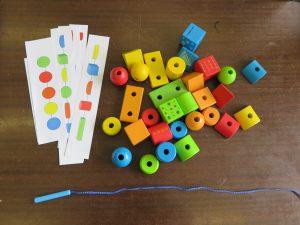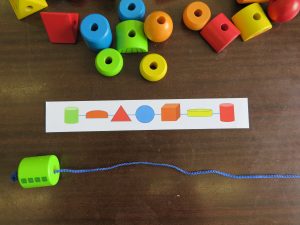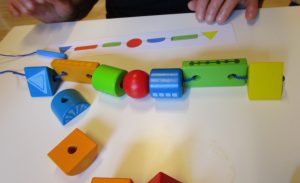
You can play MAXI BEADS if you want to enjoy a colourful and fun game that will test your coordination, perception and recognition. It is a simple game of stringing large beads of different colours and shapes. Place beads on a string in the correct order on the template or just arrange them randomly and have fun. Challenge your friend and relatives and try to make as many patterns as possible. Do not hesitate to bring up new ideas.
Basic information
Definition:
Maxi bead stick is a game of lacing or stringing. Large beads (usually made of wood or plastic) of different colors and shapes (usually cubes, spheres, pyramids or cylinders) are put on sticks or strings to form different patterns. These games promote hand-eye coordination, fine motor skills and visual perception skills.
Objectives
The objective of the game is to place large beads on a stick/ string in the correct order. The order of the beads is show on a template or can be random.
This game can be very good to improve the following cognitive dimensions:
- Praxis (hand-eye coordination, fine motor skills)
- Visual perception
- Color and pattern recognition
Duration
Duration depends on the complexity of the patterns and the player’s abilities (motoric function, motoric speed, hand-eye coordination etc.). Usually, forming one pattern takes up to 10-15 minutes.
Cost:
- Physical version: from 15€
References:
- Explanation:
- Background material: download this pdf:
Development
Participants
Participants’ profile:
- Dementia level: mild to moderate dementia levels.
- Physical requirements:
- The player must have good dexterity of arms and fingers and hand-eye coordination. For highly limited users, the game can be played using an assistant that follows the user’s instructions.
- The ability to recognize different colors and shapes.
Number of participants:
- Individually or in pairs.
Material and requirements
Materials needed to develop the game:
- In general:
- A table or other similar horizontal surface
- A chair or other comfortable surface to sit on
- Sticks, strings or other material, that beads can be placed on (straws, chopsticks etc.)
- Large wooden beads of different shapes and colors with holes in the middle
- Templates, showing different patterns of beads
Environment considerations:
- Good lighting, low noise levels
Support needed
Professionals / relatives can:
- Explain the game instructions and their variants
- Supervise the correct playing of the game.
- Guide the player by clues or hints on how to find the correct bead and how to place it on a stick/ string
- In cases of limited hand and finger movement, the assistant can pick up and place the beads on a stick/ string, on the instruction of the player; hold the string and help with lacing.
Starting point:
- Put a stick/ string and all of the beads and in front of the player. Put the template with the pattern in front of the player.
Development:
A professional or relative places all of the beads in front of the player or in the center of the table if there is more than one player. S/he gives each player their own string, stick or other (straw, chopstick, …) where beads will be placed on, and their own template, showing the pattern in which the beads must be arranged. Then, s/he encourages the player to look at the pattern on their template and try to find the corresponding beads that they will need to complete the pattern. The pattern is finished, when it is the same than on the template. Then, players can be encouraged to continue the game with a different pattern. If the player has difficulties, placing beads on a stick, a professional/ relative can help them.
If the game is played in pairs, one player can find the corresponding beads and give them to the other player who is then placing the beads on a stick/ string. When one pattern is finished, they can start working on another template, changing roles.
Instructions on how to lace maxi wooden beads can be found at:
Additional information
Variants of the game:
- The game can be played individually or in pairs
- Beads can be placed on sticks, strings, straws, or other appropriate materials
- The difficulty can be adapted by using templates with more or less beads in a pattern
Alternative games:
Similar games:
- Abacolor
- Lace and trace
- Pegs
Assessment:
- Number of different patterns made in given time (e.g. 30 minutes)
- Time needed to finish the pattern
- Help and tips needed to finish the patterns
Notes / observations
- The game is not available in ICT format
- The game can also be used as an arts and crafts activity, e.g. making bracelets, necklaces, etc.
Practical activity
Put all of the materials (beads, string and templates) in front of the player on the table.
 Choose a template you want to work with and put it in front of the player. The player puts the beads on a string one by one, to replicate the pattern shown on the template.
Choose a template you want to work with and put it in front of the player. The player puts the beads on a string one by one, to replicate the pattern shown on the template.

 A pattern is finished when all of the correct beads are placed on the string in a pattern on the template.
A pattern is finished when all of the correct beads are placed on the string in a pattern on the template.
The player can then continue playing the game using other templates. The difficulty can be increased or decreased regarding the number and type of the beads in the pattern.
![]()



